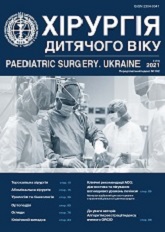The own experience of reconstructive-plastic operations on the bladder in children
DOI:
https://doi.org/10.15574/PS.2021.72.43Keywords:
augmentation ileocystoplasty, appendicocystostomy, childrenAbstract
In our country, complex surgical reconstruction of the distal urinary tract in severe bladder dysfunction in children is performed infrequently, given the number of children who need these operations. These operations were carried out in our country by specialists invited from abroad. Therefore, we want to share our first experience of performing a complex surgical reconstruction of the distal urinary tract in children.
Purpose – to іmprove the quality of life of children with severe bladder dysfunction.
Materials and methods. The results of reconstructive and plastic operations on the bladder in 7 children with severe bladder dysfunction were analyzed. Four patients had a neurogenic bladder 3 of them had a spinal bladder), and two patients had a microcyst after surgical correction of bladder exstrophy and total epispadias. Augmentation ileocystoplasty was performed in 3 children, two of them also underwent appendicocystostomy, 3 patients underwent only appendicocystostomy. An assessment of the urinary tract condition, the degree of urinary retention, postoperative complications and quality of life of operated children.
Results. All operated children recovered. The bladders in three patients after augmentation have sufficient volume and fully provide reservoir function. We did not observe metabolic acidosis or other serious metabolic disorders described by other authors in the children we operated on. Urolithiasis was also not observed after surgery. In 5 patients who underwent appendicocystostomy, the latter is well catheterized, has a good cosmetic effect. In 4 out of 5 patients there is no leakage of urine through the stoma. All operated children were recovered for vesicoureteral reflux and chronic pyelonephritis. According to the results of the survey, the improvement of most parameters of quality of life of operated patients (cessation of urinary tract infection, complete urinary retention with more infrequent and controlled urination, the ability to visit children’s groups and social adaptation of these children in society).
Conclusions. Based on the first own experience of augmentation ileocystoplasty and appendicocystostomy according to Mitrofanoff, the good efficiency of these reconstructive-plastic operations is noted. In all operated patients the quality of life significantly improved – controlled urination was achieved, the progression of kidney damage was stopped. All postoperative complications are successfully corrected. Of great importance for achieving a good effect of treatment is the correct choice of the the urinary tract surgical reconstruction type in each case.
The research was carried out in accordance with the principles of the Helsinki declaration. The study protocol was approved by the Local ethics committee of all participating institution. The informed consent of the patient was obtained for conducting the studies.
No conflict of interest was declared by the authors.
References
Altaweel W, Jednack R, Bilodeau C, Corcos J. (2006). Repeated intradetrusor botulinum toxin type A in children with neurogenic bladder due to myelomeningocele. J Urol. 175: 1102-1105. https://doi.org/10.1016/S0022-5347(05)00400-3
Atta CAM, Fiest KM, Frolkis AD, Jette N, Pringsheim T, St Germaine-Smith C et al. (2016). Global birth prevalence of spina bifida by folic acid fortification status: a systematic review and meta-analysis. Am J Public Health. 106: 24-34. https://doi.org/10.2105/AJPH.2015.302902; PMid:26562127 PMCid:PMC4695937
Averin VI. (2015). Surgical rehabilitation of children with urinary incontinence. Surgery. Eastern Europe. 3: 61-67.
Averin VI. (2019). Intestinal plastic of the bladder in patients with lower urinary tract pathology. Pediatrics: yesterday, today, tomorrow: materials of scientific-practical. conf., dedicated. 55th anniversary of the pediatrician faculty. Under scientific. Ed. V.I. Bobrovnicheva. Minsk: BSMU: 34-36.
Gor RA, Elliott SP. (2017). Surgical management of neurogenic lower urinary tract dysfunction. Urol Clin North Am. 44: 475-490. https://doi.org/10.1016/j.ucl.2017.04.013; PMid:28716327
Hoen L, Ecclestone H, Blok BFM, Karsenty G, Phe V, Bossier R et al. (2017). Long-term effectiveness and complication rates of bladder augmentation in patients with neurogenic bladder dysfunction: a systematic review. Neurourol Urodyn. 36: 1685-1702. https://doi.org/10.1002/nau.23205; PMid:28169459
Langer S, Radtke C, Gyori E, Springer A, Metzelder ML. (2019). Bladder augmentation in children: current problems and experimental strategies for reconstruction. Wiener Medizinische Wochenschrift. 169: 61-70. https://doi.org/10.1007/s10354-018-0645-z; PMid:30084093 PMCid:PMC6394595
Lapides J, Diokno AC, Gould FR, Lowe BS. (1976). Further observations on self-catheterization. J Urol. 116: 169-171. https://doi.org/10.1016/S0022-5347(17)58730-3
Lee B, Featherstone N, Nagappan P, McCarthy L, O'Toole S. (2016). British Association of Paediatric Urologists consensus statement on the management of the neuropathic bladder. J Pediatr Urol. 12: 76-87. https://doi.org/10.1016/j.jpurol.2016.01.002; PMid:26946946
Mitrofanoff P. (1980). Trans-appendicular continent cystostomy in the management of the neurogenic bladder. Chir Pediatr. 21: 297-305.
Monti PR, Lara RC, Dutra MA, de Carvalho JR. (1997). New techniques for construction of efferent conduits based on the Mitrofanoff principle. Urology. 49: 112-115. https://doi.org/10.1016/S0090-4295(96)00503-1
Nseyo U, Santiago-Lastra Y. (2017). Long-term complications of the neurogenic bladder. Urol Clin North Am. 44: 355-366. https://doi.org/10.1016/j.ucl.2017.04.003; PMid:28716317
Stein R, Bogaert G, Dogan HS, Hoen L, Kocvara R, Nijman RJM. (2020). EAU/ESPU guidelines on the management of neurogenic bladder in children and adolescent part II operative management. Neurourol Urodyn. 39: 498-506. https://doi.org/10.1002/nau.24248; PMid:31794087
Tudor KI, Sakakibara R, Panicker JN. (2016). Neurogenic lower urinary tract dysfunction: evaluation and management. J Neurol. 263: 2555-2564. https://doi.org/10.1007/s00415-016-8212-2; PMid:27401178
Downloads
Published
Issue
Section
License
The policy of the Journal “PAEDIATRIC SURGERY. UKRAINE” is compatible with the vast majority of funders' of open access and self-archiving policies. The journal provides immediate open access route being convinced that everyone – not only scientists - can benefit from research results, and publishes articles exclusively under open access distribution, with a Creative Commons Attribution-Noncommercial 4.0 international license(СС BY-NC).
Authors transfer the copyright to the Journal “PAEDIATRIC SURGERY.UKRAINE” when the manuscript is accepted for publication. Authors declare that this manuscript has not been published nor is under simultaneous consideration for publication elsewhere. After publication, the articles become freely available on-line to the public.
Readers have the right to use, distribute, and reproduce articles in any medium, provided the articles and the journal are properly cited.
The use of published materials for commercial purposes is strongly prohibited.

